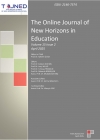TOJNED - Volume 11 - Issue 2 - April 2021
 A REVIEW OF MEASUREMENT AND ASSESSMENT IN DISTANCE EDUCATION
A REVIEW OF MEASUREMENT AND ASSESSMENT IN DISTANCE EDUCATION Osman Vaiz, Nesrin M. Bahçelerli, Hüseyin Minalay, Ayhan Türe, Pelin Ülgener, Hasan Yaşar
Abstract:
This research aims to examine the functioning of the measurement and assessment process in distance education. Developments in education and communication technologies have enabled the development of distance education applications. Therefore, measurement and assessment methods are developing in parallel with these developments. This research was carried out with a compilation of qualitative research methods. The keywords determined for the purpose of the study were examined in the literature and the research findings were brought together. Alternative measurement and assessment methods that can be used within the scope of distance education include techniques such as portfolio, concept map, peer assessment, and performance evaluation. As a result of the research, it is seen that the use of process-oriented measurement and assessment methods within the scope of distance education enables the monitoring of the progress of the student and in this case, teachers can fulfill their guiding missions in distance education.
 PROVISION OF QUALITY SERVICE IN ETHIOPIAN PUBLIC UNIVERSITIES AND STUDENTS' SATISFACTION: INSIGHTS FROM ARBA MINCH UNIVERSITY
PROVISION OF QUALITY SERVICE IN ETHIOPIAN PUBLIC UNIVERSITIES AND STUDENTS' SATISFACTION: INSIGHTS FROM ARBA MINCH UNIVERSITY Zelalem Zekarias Oliso
Abstract:
The present study examines the link between service quality and students' satisfaction at Arba Minch University (hereinafter AMU). To this end, the study used quantitative correlational design with adapted questionnaire as the main data gathering tool. The collected data were analyzed using descriptive statistics and inferential statistics. The findings reveal that there is a statistically significant, moderate and positive correlation between educational service quality and students' satisfaction (r=.623) and five dimensions of service quality explained 41% percent of the variations in students' satisfaction. The quantitative data further uncovered that among five facets of service quality, viz., core educational quality, support facilities and transformative quality make strongest effect on students' satisfaction. Whist administrative quality and physical environment make moderate effect on students' satisfaction. Finally, based these findings, recommendations were forwarded to improve students' learning.
 TEACHER QUALITY: EPICENTRE OF THE LEARNING PROCESS AT HIGHER EDUCATION
TEACHER QUALITY: EPICENTRE OF THE LEARNING PROCESS AT HIGHER EDUCATION Bahar GĂĽn
Abstract:
With the increasing importance attached to teacher quality, lecturers at higher education institutions are increasingly expected to know not only subject knowledge, but also pedagogical knowledge, which entails many different aspects of teaching and learning processes and practices. The purpose of this qualitative study is to report on a research project aiming to improve the university lecturers’ classroom teaching performance. There is a detailed description of the in-service training program offered to university lecturers, and an analysis of the main set of data from the feedback collected from the participant lecturers, leading to more general implications for university lecturers’ pedagogical skills in higher education institutions.
The teacher is at the epicentre of the learning process...learning, therefore, depends first and foremost on the quality of the teacher. (Schwille et al, 2007:15)
 TEACHING DIGITAL LITERATURE: AN APPLIANCE OF DISTANT READING & TOPIC MODELING TO THE TEACHING SCENARIO
TEACHING DIGITAL LITERATURE: AN APPLIANCE OF DISTANT READING & TOPIC MODELING TO THE TEACHING SCENARIO Meisam Moghadam, Niloofar Jafarpour
Abstract:
The current article tries to provide practical arguments to support the appliance of the digital methods and tools into the teaching literature curriculum in favor of distant reading of going beyond the limitations of canon and time. In this regard, a teaching literature scenario is presented to facilitate and fasten reading literature by making students familiar with the computer application in their literature studies through analyzing the resulted data from a project done by Dr. Rachel Sagner Buurma, on Victorian Literature. The chosen application is Topic Modeling, performed by the popular topic modeling tool, MALLET. The paper develops a practical three-phased scenario to be implemented in literature classroom and elaborates on the way to work with the meaning and the usages of the resulted topics and patterns. Finally, the article explores the positive and negative aspects of the presented scenario and concludes that the digital tool is not a substitute for the existing teaching material, but a supportive method to open the new perspectives in literary studies which is an adjusting method to students of the age of technology. Moreover, further research is suggested focusing on the Teaching Literature materials of curriculum targeting especially the history of literature or discovering specific new dimensions above from the accustomed theories.
 THE INTROVERTED STUDENTS IN THE MODERN ESL/EFL CLASSROOM
THE INTROVERTED STUDENTS IN THE MODERN ESL/EFL CLASSROOM Elena Shalevska
Abstract:
As ESL/EFL studies become more focused on group-work and pair-work, introverted students remain in the background of the modern classrooms. With the majority of the newer student textbooks focusing on team building and joint activities, introverted students cannot step out of the extroverts’ shadow. Research even suggests that teachers prefer the extroverted students who happily participate in class discussions and group activities over the quiet, inward-oriented introverts.
Many regard the introverted students as shy, but introversion is not limited to shyness. This paper will discuss the ways in which introverts can improve their participation in class and improve their skills for working as a part of a group.
Small but meaningful changes to the ways we teach ESL/EFL can influence the teaching process for the introverts greatly.
 THE ROLE OF LEARNING MOTIVATION IN MEDIATING LEARNING OUTCOMES
THE ROLE OF LEARNING MOTIVATION IN MEDIATING LEARNING OUTCOMES Agung Listiadi
Abstract:
Education is an effort to realize the ideals of the nation. To achieve good education, learning facilities, teacher teaching skills, interest in learning and learning motivation are needed. Learning facilities are needed by schools to be right on target and effective in their use. The effectiveness of the provision of learning facilities can improve the quality of learning. Besides that, in creating fun, effective, and innovative learning, a teacher needs a skill. If students have an interest in the teaching material being studied, they will study seriously and can obtain optimal learning outcomes because they like it and will feel satisfied when their wishes have been fulfilled. Respondents in this study were 80 student teacher candidates. The study used a path analysis design. The results of the study of learning motivation mediate learning facilities, teacher teaching skills and learning interest on learning outcomes.


